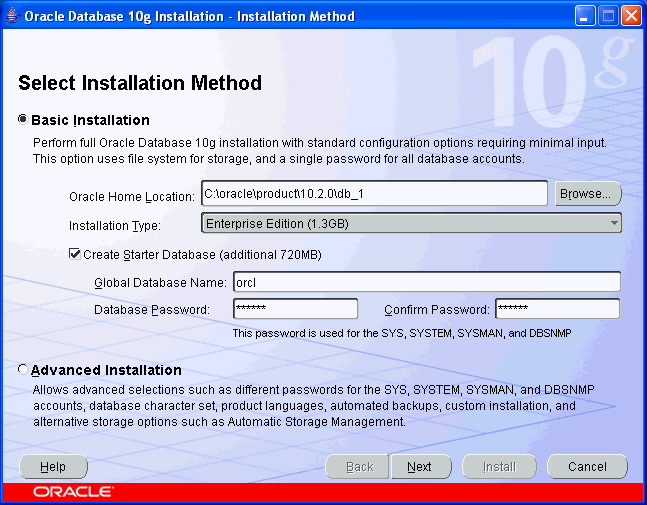| Oracle® Database 2 Day DBA 10g Release 2 (10.2) Part Number B14196-02 |
|
|
PDF · Mobi · ePub |
| Oracle® Database 2 Day DBA 10g Release 2 (10.2) Part Number B14196-02 |
|
|
PDF · Mobi · ePub |
This section describes the basic installation steps. Most steps are common to all platforms and involve running the Oracle Universal Installer. Platform-specific steps are noted.
The following steps provide a summary of the installation process. For further assistance along the way, consult the online help or the Oracle Database Installation Guide for your platform.
Log on to your computer as a member of the administrative group that is authorized to install Oracle software and to create and run the database. Refer to your operating system-specific documentation or contact your system administrator to determine whether you have the necessary privileges to install new software.
Insert the distribution media for the database into your computer. The Autorun window opens automatically. Click Install/Deinstall Products.
If downloading from Oracle's Web site, then follow the instructions on the site.
The Oracle Universal Installer Select Installation Method window appears. Figure 2-1 shows what this window looks like on Windows.
Figure 2-1 Oracle Universal Installer Select Installation Method Window

You must now decide which type of installation to perform:
Basic Installation—Select this option to quickly install Oracle Database 10g. This method requires minimal user input. It installs the software and optionally creates a general-purpose database based on the information you provide.
For basic installation, you specify the following:
Oracle Home Location—Enter the directory in which to install the Oracle Database 10g software. You must specify a new Oracle home directory for each new installation of Oracle Database 10g.
Installation Type—Select either Enterprise Edition, Standard Edition, or Personal Edition (Windows Only). Refer to "Basic Installation".
UNIX DBA Group (Linux and Unix only)—Specify the DBA group for your operating system.
Create Starter Database —Check this box to create a database during installation. Oracle recommends that you create a starter database for first-time installations. You must enter a Global Database Name and Database Password for the SYS, SYSTEM, SYSMAN, and DBSNMP administrator accounts. The Global Database Name is described in "Basic Installation".
To start the basic installation, click Next. The Preparing to Install progress bar appears.
Advanced Installation—Select this option to customize your installation. For example, use this method to install Oracle Real Application Clusters, to upgrade a database, to configure Automatic Storage Management, or to configure automated backups. Selecting this option steps you through installation steps not documented here. For more information about the advanced choices, see "Advanced Installation" in this chapter. Also see the Oracle Database Installation Guide for your platform.
The Product-Specific Prerequisite Checks window appears. Refer to "Checking Prerequisites". The Installer performs a number of environment checks and indicates success, warning, or failure. Details of the checks are provided. The installation can only proceed with check status of Succeeded or Warning. If you have failed checks, you must resolve them manually.
After verifying that your system meets the minimum requirements for installing and configuring the chosen products, click Next.
Linux and Unix Only. If this is the first time you are installing any Oracle software on this machine, then the following occurs:
The Specify Inventory Directory window appears. You must specify a directory for installation files and the name of an operating system group that has write permission to the directory. OUI uses this location to keep track of all Oracle software. This information is used while applying patches or upgrading an existing installation, and while deinstalling Oracle software. Note that this area is different from the Oracle home, which you specify later.
Click Next to continue.
A summary screen appears showing information such as your global settings, space requirements and the new products to be installed. Click Install to start the installation. The Install window appears showing installation progress.
At the end of the installation phase, the Configuration Assistants window appears. This window lists the configuration assistants that are started automatically. If you are creating a database, then the Database Configuration Assistant starts automatically in a separate window.
At the end of database creation, you are prompted to unlock user accounts to make the accounts accessible. The SYS and SYSTEM accounts are already unlocked. Click OK to bypass password management.
Linux and Unix Only. The Execute Configuration scripts window appears. You are prompted to open a new terminal window, and to run scripts as the root user. After you run the scripts, return to this window and click Ok.
Your installation and database creation is now complete. The End of Installation window displays several important URLs, one of which is for Enterprise Manager. You can navigate to this URL in your browser and log in as the SYS user with the associated password, and connect as SYSDBA. You use Enterprise Manager to perform common database administration tasks. See Chapter 3, "Getting Started with Oracle Enterprise Manager".
After noting the information in the End of Installation screen, you can exit the Installer.